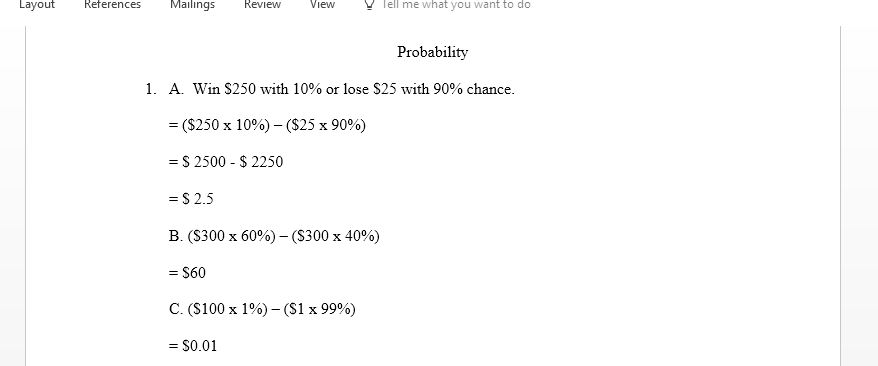Calculate the fair price of the following gambles
1. Calculate the fair price of the following gambles. Please show your work.
a. Win $250 with a 10 percent chance or lose $25 with a 90 percent chance.
b. Lose $300 with a 60 percent chance or win $300 with a 40 percent chance.
c. Win $100 with a 1 percent chance or lose $1 with a 99 percent chance.
2. I’m a fairly risk-averse person; my utility function over wealth is , where W is my wealth in dollars. Suppose I currently have $100,000 in wealth, but I have the opportunity to have an experimental surgery. If it is successful—and it is 10 percent of the time—I will become tall, fit, and handsome, have an awesome career in film, and my wealth will skyrocket to $10 million. If it fails, however, I remain myself, but with chronic pain that is the equivalent of being $50,000 less wealthy.
a. Would I buy this surgery if it cost $50,000? Show me why or why not.
b. What’s the fair price for this surgery?
3. This is a modified version of 4.8 from the text: Sophia is a contestant on a game show and has selected the prize that lies behind door number 3. The show’s host tells her that there is a 50 percent chance that there is a $15,000 diamond ring behind the door and a 50 percent chance that there is a goat behind the door (which is worthless to Sophia, who is allergic to goats). Before the door is opened, someone in the audience shouts, “I’ll give you the option of selling me what is behind the door for $8,000 if you will pay me $4,500 for the option.”
a. If Sophia only cares about the expected value of various outcomes, will she buy this option? Show me mathematically how you know. (Hint: Would she sell the ring? How about the goat?)
b. If Sophia has no starting wealth, and her utility of wealth is , would she benefit from taking this option? Again, show me how you know.
4. Suppose I consume 3 packages of Reese’s cups with every Red Bull I drink every day (yes, I know, my diet is horrible).
a. Write out my utility function (note—this isn’t about risk!).
b. Draw my , , and indifference curves.
c. Suppose a package of Reese’s costs $1, while a Red Bull costs $2. If I have $20 to spend, solve for my daily consumption of each. In a new graph, show me my budget constraint and the indifference curve I can reach.
6. Derive the demand curve good X for the utility function . Show your work.
Answer preview for Calculate the fair price of the following gambles
Access the full answer containing 233 words by clicking the below purchase button

